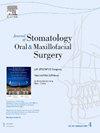Longitudinal evaluation of prognostic factors influencing the outcomes of functional appliance therapy in juvenile idiopathic arthritis patients with temporomandibular joint involvement
IF 2
3区 医学
Q2 DENTISTRY, ORAL SURGERY & MEDICINE
Journal of Stomatology Oral and Maxillofacial Surgery
Pub Date : 2025-10-01
DOI:10.1016/j.jormas.2025.102496
引用次数: 0
Abstract
Introduction
Temporomandibular joint (TMJ) involvement is a common yet under-recognized manifestation of Juvenile Idiopathic Arthritis (JIA) which can impair craniofacial growth and oral function. While early functional orthopaedic intervention holds promise, evidence from long-term studies evaluating outcomes and predictors of treatment response remains sparse.
Materials and Methods
This prospective longitudinal study included 84 children (mean age: 12.3 ± 2.1 years) diagnosed with JIA and clinical TMJ involvement. All participants were treated with a standardized modified twin-block appliance over a 2-year period. Clinical, skeletal, inflammatory and quality-of-life assessments were performed at six time points using Maximum Interincisal Opening (MIO), Visual Analog Scale (VAS) for pain, cephalometry (SNB angle), C-reactive protein (CRP), erythrocyte sedimentation rate (ESR), autoantibodies (RF, ANA, anti-CCP), cone-beam computed tomography (CBCT) and the OHIP-14 questionnaire. Prognostic factors and relapse were evaluated using multivariate regression and Kaplan–Meier survival analysis.
Results
Over 24 months, patients demonstrated statistically significant improvement in MIO (+7.6 mm), VAS pain score (–3.9), SNB angle (+3.6°), ESR (–14.7 mm/hr) and CRP (–6.9 mg/L) (p < 0.001). Poorer outcomes were associated with RF/anti-CCP positivity, elevated baseline ESR/CRP, severe TMJ changes on CBCT and extra-articular involvement. In contrast, children aged ≤12 years with overjet ≤5 mm, SNB angle ≥76° and mild radiographic findings showed better therapeutic response. The 2-year relapse-free survival rate was 63.1 %.
Conclusion
Modified twin-block therapy appears to be a promising adjunct for managing TMJ involvement in JIA. Early intervention, mild radiographic pathology and absence of seropositivity were strong predictors of sustained improvement highlighting the need for timely diagnosis and individualized orthopaedic planning.
影响颞下颌关节受损伤青少年特发性关节炎患者功能矫治器治疗预后因素的纵向评价。
颞下颌关节(TMJ)受损伤是青少年特发性关节炎(JIA)常见但未被充分认识的表现,可损害颅面生长和口腔功能。虽然早期的功能性矫形干预有希望,但长期研究评估结果和治疗反应预测因素的证据仍然很少。材料和方法:本前瞻性纵向研究纳入84例确诊为JIA并临床累及TMJ的儿童(平均年龄:12.3 ± 2.1岁)。在2年的时间里,所有的参与者都接受了标准化的改良双块矫治器的治疗。在6个时间点进行临床、骨骼、炎症和生活质量评估,采用最大切壁间隙(MIO)、疼痛视觉模拟量表(VAS)、头测术(SNB角)、c反应蛋白(CRP)、红细胞沉降率(ESR)、自身抗体(RF、ANA、anti-CCP)、锥束计算机断层扫描(CBCT)和o髋关节-14问卷。使用多变量回归和Kaplan-Meier生存分析评估预后因素和复发。结果:在24个月的时间里,患者在MIO(+7.6 mm)、VAS疼痛评分(-3.9)、SNB角度(+3.6°)、ESR(-14.7 mm/hr)和CRP(-6.9 mg/L) (p )方面表现出统计学上的显著改善。结论:改良双阻滞治疗似乎是治疗JIA颞颌关节受损伤的一种有希望的辅助治疗方法。早期干预、轻度影像学病理和无血清阳性是持续改善的有力预测因素,强调了及时诊断和个性化骨科计划的必要性。
本文章由计算机程序翻译,如有差异,请以英文原文为准。
求助全文
约1分钟内获得全文
求助全文
来源期刊

Journal of Stomatology Oral and Maxillofacial Surgery
Surgery, Dentistry, Oral Surgery and Medicine, Otorhinolaryngology and Facial Plastic Surgery
CiteScore
2.30
自引率
9.10%
发文量
0
审稿时长
23 days
 求助内容:
求助内容: 应助结果提醒方式:
应助结果提醒方式:


